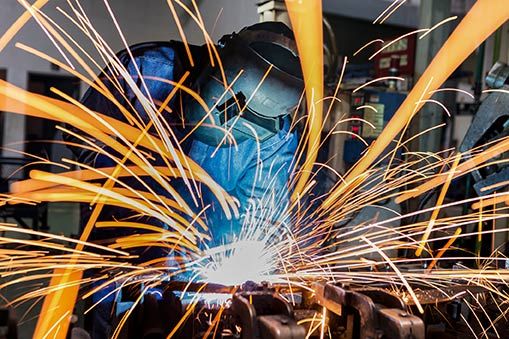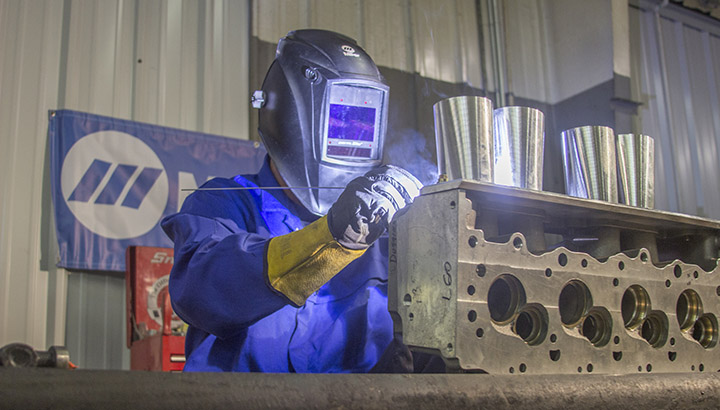Typical Welding Repair Issues and Exactly How to Address Them Effectively
Welding fixings commonly experience a range of concerns that can jeopardize the honesty of the final item. Typical issues consist of poor infiltration, porosity, and misalignment, amongst others. Each flaw presents one-of-a-kind challenges that call for particular strategies for resolution. Recognizing these issues is important for welders aiming to improve their outcomes and abilities. This discussion will check out these common welding fixing issues and effective approaches to address them.
Insufficient Infiltration
Poor infiltration takes place when the weld metal falls short to completely fuse with the base product, causing weak joints and prospective architectural failures. This concern usually originates from insufficient warmth input, incorrect electrode angle, or improper welding speed. Welders might run into inadequate penetration because of a mistake of the essential specifications for a certain material thickness or type. Additionally, contamination on the base product's surface can impede reliable bonding, exacerbating the issue. To attend to poor infiltration, welders ought to guarantee suitable setups on their tools and maintain a tidy work surface area. Regular inspection of welds is advised to recognize any kind of shortages early, allowing for prompt improvements and the avoidance of endangered architectural stability in welded settings up.
Porosity
Porosity is an usual issue in welded joints that materializes as little gas bubbles caught within the weld metal. This issue can endanger the honesty of the weld, bring about lowered toughness and possible failure under stress. Belgrade Welding. Porosity typically arises from contamination, wetness, or improper welding methods, which enable gases to leave into the molten weld swimming pool. To attend to porosity, welders should ensure proper surface area preparation, maintain a tidy functioning atmosphere, and utilize suitable welding specifications. Additionally, picking the best filler product and protecting gas can minimize gas entrapment. Routine evaluation and screening of welds can assist identify porosity early, assuring prompt corrective actions are taken, therefore preserving the top quality and reliability of the bonded structure
Misalignment
Imbalance in welding can occur from different variables, including incorrect arrangement and thermal growth. Recognizing the root causes is important for reliable resolution. Numerous modification methods are offered to straighten parts and ensure architectural stability.
Sources of Misalignment
Welding misalignment typically comes from a range of underlying issues that can endanger architectural integrity. One key reason is inappropriate fit-up of parts before welding, which can bring about voids and uneven surfaces. Variants in thermal expansion during the welding process can likewise lead to distortion, particularly if the products being signed up with have various coefficients of expansion. In addition, insufficient fixturing and clamping might stop working to hold elements firmly in place, bring about movement throughout welding. Badly conserved tools, consisting of welding equipments and devices, might present disparities in the weld grain, additional adding to misalignment. Lastly, operator mistake, originating from inadequate training or experience, can likewise play a substantial duty in producing misaligned welds.
Improvement Techniques Available
Resolving misalignment properly calls for a mix of corrective methods tailored to the specific issues handy. One usual method is making use of jigs or fixtures to hold elements in the appropriate position during welding, making sure constant alignment. Furthermore, pre-heating the products can help lower distortion and boost fit-up. For significant misalignment, mechanical adjustment methods, such as making use of hydraulic jacks or clamps, can be used to fix the setting prior to welding. Post-weld warmth treatment may additionally be necessary to soothe anxieties brought on by misalignment. Ultimately, mindful examination and modification during the configuration phase can avoid misalignment concerns from becoming significant troubles, advertising a smoother welding procedure and enhancing general architectural honesty.
Distortion
Distortion is a typical difficulty in welding that can arise from various aspects, including unequal home heating and cooling. Recognizing the root causes of distortion is essential for implementing efficient avoidance strategies. Resolving this issue not only boosts structural honesty yet additionally enhances the overall quality of the weld.
Sources of Distortion
When based on the extreme heat of welding, products typically undergo modifications that can bring about distortion. This sensation primarily occurs from thermal development and tightening during the welding process. As the weld location warms up, the product broadens; upon cooling, it gets, which can develop internal stresses. In addition, unequal heating across a workpiece can intensify these tensions, resulting in bending or bending. The sort of material likewise plays a considerable duty; steels with varying thermal conductivity and coefficients of growth might respond in different ways, causing unpredictable distortions. Furthermore, inadequate joint design and inadequate fixturing can add to imbalance throughout welding, enhancing the likelihood of distortion. Understanding these causes is necessary for efficient welding repair work and prevention approaches.
Avoidance Techniques
Reliable prevention techniques for distortion throughout welding concentrate on managing warm input and guaranteeing appropriate joint style. Maintaining a consistent warmth input helps to lessen thermal growth and tightening, which can result in distortion. Making use of methods such as preheating the work surface can also decrease the temperature slope, promoting uniform heating. Additionally, choosing appropriate joint layouts, such as T-joints or lap joints, can boost security and reduce anxiety concentrations. Applying correct fixturing to safeguard the workpieces in position better help in keeping alignment throughout the welding process. Lastly, staggered welding sequences can distribute heat extra evenly, preventing local distortion. By using these techniques, welders can greatly decrease the possibility of distortion and boost the overall high quality of their welds.
Cracking
Splitting is an usual issue experienced in welding fixings, commonly arising from different variables such as inappropriate cooling rates, product option, or poor joint preparation. The incident of fractures can substantially endanger the honesty of the weld, bring check here about potential failures throughout operation. To address this concern, welders need to first evaluate the origin, making certain that products are compatible and appropriately chosen for the specific application. Furthermore, controlling the air conditioning rate throughout the welding procedure is vital; quick air conditioning can cause stress and anxiety and result in breaking. Proper joint design and preparation also add to minimizing the danger. Applying these methods can enhance weld top quality and sturdiness, eventually minimizing the likelihood of breaking in ended up weldments.

Insufficient Blend
A substantial problem in welding repairs is incomplete fusion, which happens when the weld steel does not properly bond with the base material or previous weld passes - Belgrade Fabrication. This flaw can cause weaknesses in the joint, potentially compromising the honesty of the welded framework. Factors contributing to incomplete combination consist of not enough heat input, inappropriate welding technique, and contamination of the surface areas being signed up with. To address this concern properly, welders must ensure appropriate pre-weld cleansing and surface preparation, along with change their welding criteria to attain adequate penetration and blend. Regular examination during the welding process can likewise help identify insufficient blend early, enabling timely restorative actions to improve the overall high quality of the weld
Overheating
While welding fixings can boost architectural honesty, overheating offers a significant obstacle that can lead to material destruction. Too much warmth during welding can change the mechanical homes of metals, leading to lowered toughness, enhanced brittleness, and bending. This phenomenon is particularly crucial in high-stress applications where structural integrity is paramount. Identifying getting too hot can include visual assessments for discoloration or distortion, in addition to keeping an eye on temperature throughout the welding procedure. To mitigate the threats related to getting too hot, welders need to utilize appropriate strategies, such as controlling heat input, adjusting travel rate, and utilizing suitable filler products. Furthermore, applying pre- and post-weld warmth treatments can help restore material buildings and boost the total quality of the fixing, making certain long-lasting efficiency and safety and security.
Frequently Asked Concerns
What Are the Typical Indications of a Welding Issue?

How Can I Examine My Welds for High quality?
To check welds for top quality, one can use visual evaluations, ultrasonic testing, and radiographic approaches. Each method ensures structural honesty, identifies problems, and validates adherence to defined criteria, eventually enhancing the reliability of the welded joints.
What Safety Precautions Should I Take While Welding?
When welding, one should focus on safety and security by using appropriate individual safety equipment, guaranteeing correct ventilation, safeguarding combustible products away, maintaining a clean work space, and understanding environments to stop injuries and crashes.
Can I Repair a Weld Without Redesigning the Entire Joint?
Repairing a weld without renovating the entire joint is possible, depending on the damages (Belgrade). Techniques such as grinding, including filler material, or using a welding process can effectively deal with particular problems while preserving the surrounding framework
What Devices Are Essential for Effective Welding Fixes?
Important tools for effective welding repair services consist of a welding machine, wire brush, mill, safety gear, clamps, and filler products. Each tool plays a crucial function in making sure high quality and security during the repair work procedure. Porosity generally develops from contamination, wetness, or inappropriate welding methods, which enable gases to get away right into the liquified weld pool. Improperly kept equipment, consisting of welding equipments and devices, may introduce inconsistencies in the weld grain, further contributing to imbalance. When subjected to the extreme warm of welding, products often undergo changes that can lead to distortion. Cracking is an usual issue experienced in welding repairs, frequently resulting from numerous aspects such as inappropriate cooling rates, product choice, or insufficient joint preparation. A significant issue in welding fixings is incomplete fusion, which takes place when the weld steel does not adequately bond with the base product or previous weld passes.
Comments on “What to learn about overheating prevention from Montana Mobile Welding and Repair”